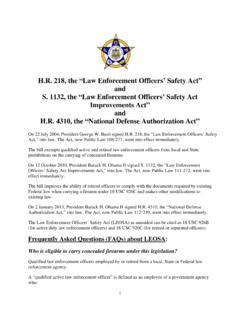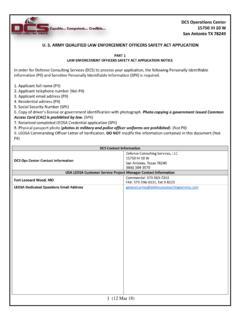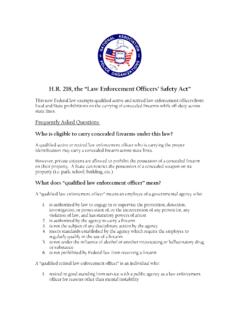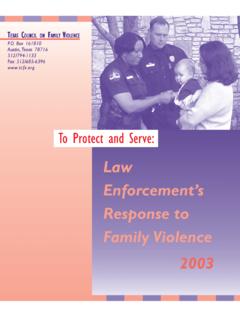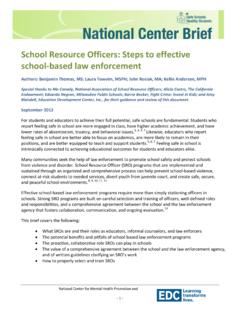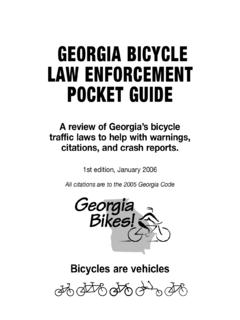Transcription of H.R. 218, the “Law Enforcement Officers’ Safety …
1 218, the Law Enforcement Officers' Safety Act . and S. 1132, the Law Enforcement Officers' Safety Act Improvements Act . and 4310, the National Defense Authorization Act . On 22 July 2004, President George W. Bush signed 218, the Law Enforcement Officers' Safety Act, into law. The Act, now Public Law 108-277, went into effect immediately. The bill exempts qualified active and retired law Enforcement officers from local and State prohibitions on the carrying of concealed firearms. On 12 October 2010, President Barack H. Obama II signed S. 1132, the Law Enforcement Officers' Safety Act Improvements Act, into law. The Act, now Public Law 111-272, went into effect immediately. The bill improves the ability of retired officers to comply with the documents required by existing Federal law when carrying a firearm under 18 USC 926C and makes other modifications to existing law. On 2 January 2013, President Barack H. Obama II signed 4310, the National Defense Authorization Act, into law.
2 The Act, now Public Law 112-239, went into effect immediately. The Law Enforcement Officers' Safety Act (LEOSA) as amended can be cited as 18 USC 926B. (for active duty law Enforcement officers) and 18 USC 926C (for retired or separated officers). Frequently Asked Questions (FAQs) about LEOSA: Who is eligible to carry concealed firearms under this legislation? Qualified law Enforcement officers employed by or retired from a local, State or Federal law Enforcement agency. A qualified active law Enforcement officer is defined as an employee of a government agency who: 1. is authorized by law to engage in or supervise the prevention, detection, investigation, prosecution or the incarceration of any person for any violation of law;. has statutory powers of arrest or apprehension under the Uniform Code of Military Justice;. is authorized by the agency to carry a firearm;. is not the subject of any disciplinary action by the agency which could result in suspension or loss of police powers.
3 Meets the standards, if any, established by the agency which require the employee to regularly qualify in the use of a firearm;. is not under the influence of alcohol or another intoxicating or hallucinatory drug or substance, and is not prohibited by Federal law from possessing a firearm. The law also defines law Enforcement officers employed by the Amtrak Police Department and the Federal Reserve Police Department to be qualified active law Enforcement officers even though these are not employees of a governmental agency. Further, any law Enforcement or police officer of the executive branch of the Federal Government is also included in the definition. The most recent amendment to LEOSA further clarifies that law Enforcement officers employed by the Department of Defense who may not be deemed as having statutory powers of arrest, . but who did have the authority, under the Uniform Code of Military Justice (UCMJ), to apprehend suspects, meet the definition of qualified law Enforcement officer .
4 Qualified active law Enforcement officers must carry the photographic identification issued by the agency for which they are employed. If you are an active duty law Enforcement officer with any local, State or Federal governmental agency and you meet all of the requirements above, you may carry a concealed firearm under the provisions set out in the law. A qualified retired law Enforcement officer is defined as an individual who: has separated from service in good standing with a government agency as a law Enforcement officer for an aggregate of ten (10) years or more or separated from such an agency due to a service-connected disability after completing any applicable probationary period of such service;. was authorized by law to engage in or supervise the prevention, detection, investigation, prosecution or the incarceration of any person for any violation of law;. had statutory powers of arrest or apprehension under the Uniform Code of Military Justice.
5 Is not under the influence of alcohol or another intoxicating or hallucinatory drug or substance; and is not prohibited by Federal law from possessing a firearm. The law also defines law Enforcement officers formerly employed by the Amtrak Police Department and the Federal Reserve Police Department to be qualified active law Enforcement officers even though these were not employees of a governmental agency. Further, any former law Enforcement or police officer of the executive branch of the Federal Government is also included in the definition. 2. The most recent amendment to LEOSA further clarifies that former law Enforcement officers employed by the Department of Defense who may not have been deemed as having statutory powers of arrest, but who do have the authority, under the Uniform Code of Military Justice (UCMJ), to apprehend suspects, meet the definition of qualified law Enforcement officer .. Qualified retired law Enforcement officers must carry the photographic identification issued by the agency for which they were employed and have now separated.
6 An officer separating from service with his agency who has been officially found by a qualified medical professional employed by the agency to be unqualified for continued service for reasons related to mental health and, for that reason is not issued the photographic identification described above and in the statute, is not a qualified retired law Enforcement officer as described in 18 USC. 926C. Similarly, an officer who has entered into an agreement with the agency from which he is separating which acknowledges that the officer is not qualified under 18 USC 926C for reasons related to mental health and for these reasons will not receive or accept the photographic identification described above is not a qualified retired law Enforcement officer as described in 18. USC 926C. In addition to carrying the photographic identification issued by the agency for which they were employed or were separated, the qualified retired law Enforcement officer must also carry documentation which certifies that they have met, within the most recent twelve month period, the active duty law Enforcement standards for qualification for a firearm of the same type as the one they intend to carry.
7 The standard the qualified retired law Enforcement officer must meet is that of his former agency, that of the State in which he resides, or in the absence of State standards or the recognition thereof the standards of any law Enforcement agency in the State in which the qualified retired law Enforcement officer and the certified firearms instructor resides. This document which certifies that the qualified retired law Enforcement officer has met the standards described above must be issued by the retired officer 's former agency, by the State in which he lives, or by a certified firearms instructor that is qualified to conduct a firearms qualification test for active duty officers within that State. Do I need a concealed carry permit from my State or any other documentation to carry lawfully? No. Qualified active and retired law Enforcement officers do not need any additional concealed carry permits or licenses. Federal law exempts them from local and State prohibitions on the carriage of concealed firearms.
8 A qualified law Enforcement officer needs to carry his photographic identification issued to him by his agency. A retired law Enforcement officer needs to carry his photographic identification issued to him by the agency from which he has separated and a document that certifies that he has met, within the most recent twelve month period, the active duty law Enforcement standards for qualification for a 3. firearm of the same type as the one he intends to carry. See above for more information on the standards a qualified retired officer must meet and what entities can issue this certification document. Can I carry any type of firearm or ammunition under this law? No. The exemption provided under this Federal law applies to the carriage of concealed firearms only. The definition of firearm in this statute specifically excludes machine guns, silencers, explosives or other destructive devices as these terms are defined in Federal law.
9 However, the Federal law does extend the exemption to allow the carriage of ammunition not expressly prohibited by Federal law or subject to the provisions of the National Firearms Act.. This means that qualified active and retired law Enforcement officers may carry ammunition in States which may have prohibited the possession of certain ammunition by persons not actively serving in law Enforcement within that State. Am I also exempt from State laws prohibiting the possession or use of high capacity magazines? No. The Bureau of Alcohol, Tobacco, Firearms and Explosives (ATF) has ruled that State and local laws and regulations applying to magazines do apply and the exemption provided by LEOSA. applies only to firearms and ammunition. Is the exemption provided by the law total can I now carry anywhere at any time? No. The new law exempts all qualified active and retired law Enforcement officers from State and local laws with respect to the carrying of concealed firearms.
10 These officers are not exempt from Federal law or regulation, which governs the carriage of firearms onto aircraft or other common carriers, Federal buildings, Federal property, or national parks. In addition, State (not local) laws which prohibit the carriage of firearms onto State or local government property and State (not local) laws which allow private entities to prohibit firearms on their private property would still apply to qualified active and retired law Enforcement officers. The law says I am exempt from the laws of any State or any political subdivision thereof. Does this mean the law is not effective in Washington, , Puerto Rico, or other territories? No. The law applies in these places as well. The term State is defined in Chapter 44 of Title 18, which is the portion of the Code that the Law Enforcement Officers' Safety Act amends, and the one that applies when interpreting this Act. Section 921, Chapter 44 of Title 18 reads: The term State' includes the District of Columbia, the Commonwealth of Puerto Rico, and the possessions of the United States (not including the Canal Zone).
